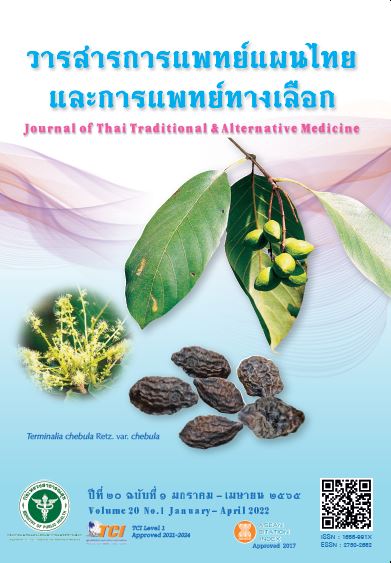Physico-Chemical Properties of Fingerroot (Boesenbergia rotunda) Crude Drug
Main Article Content
Abstract
The study on physico-chemical properties of fingerroot (Boesenbergia rotunda (L.) Mansf.), or krachai in Thai, crude drug, derived from the rhizomes and roots of the herb, aimed to establish the quality specifications of this medicinal plant. That was because there were no standard criteria for quality control of the crude drug in the Thai Herbal Pharmacopoeia, which is the national standard for herbal drugs. Seventeen fingerroot samples were collected during September 2014–January 2017. Chemical identification methods were developed and physico-chemical properties were evaluated. The methanolic extract of the crude drug gave a positive result with Shinoda’s test. Pinostrobin was detected when TLC analysis was performed on silica gel 60 using a mixture of dichloromethane-methanol (70:1) as mobile phase. The amounts of moisture and volatile oil were 7.83+0.96%, and 2.11+0.43% v/w, respectively. The amounts of total ash, acid-insoluble ash, 95% ethanol extractive, 50% ethanol extractive and water extractive were 6.68+0.88%, 1.20+0.73%, 12.63+4.31%, 15.78+2.54% and 17.63+3.35% w/w, respectively. Quality specifications of the fingerroot crude drug were set up as follows: flavonoids could be detected by Shinoda’s test; pinostrobin could be observed in the TLC analysis; the moisture content should not be higher than 9% v/w; the amounts of total ash, acid-insoluble ash should not be more than 7% and 1% w/w, respectively; the amounts of 95% ethanol extractive, 50% ethanol extractive and water extractive should not be less than 11%, 14% and 16% w/w, respectively; and the amount of volatile oil should not be less than 2% v/w. The results of this study will be proposed for inclusion as a monograph in the Thai Herbal Pharmacopoeia to be used as national reference standards of fingerroot crude drug.
Article Details

This work is licensed under a Creative Commons Attribution-NonCommercial-NoDerivatives 4.0 International License.
References
Office of the Royal Society. Royal Institute Dictionary 2011. Bangkok: Siriwattana Interprint Co. Ltd.; 2013. p. 28. (in Thai)
Department of Thai Traditional and Alternative Medicine. Monographs of Selected Thai Materia Medica Volume 2. Bangkok: Amarin Printing and Publishing Co., Ltd.; 2015. p. 21-5. (in Thai)
National List of Essential Medicines B.E. 2019. Published in Government Gazette, Vol. 124, Part 95D. (2019 April 17). (in Thai)
Pattamadilok D, Sakpetch A. Isolation of pinostrobin, a chemical marker from fingerroots for quality control purposes. J Thai Trad and Alt Med. 2021;19(2):424-34. (in Thai)
Kanjanasiritat P, Suksatu A, Manopwisedjaroen S, Munyoo B, Tuchinda P, Jearawuttanakul K, Seemakhan S, Charoensutthivarakul S, Wongtrakoongate P, Rangkasenee N, Pitiporn S, Waranuch N, Chabang N, Khemawoot P, Sa-ngiamsuntorn K, Pewkliang Y, Thongsri P, Chutipongtanate S, Hongeng S, Borwornpinyo S, Thitithanyanont A. High-content screening of Thai medicinal plants reveals Boesenbergia rotunda extract and its component panduratin A as anti-SAR-CoV-2 agents. Sci Rep [Open Access] 2020;10(19963). doi: 10.1038/s41598-020-77003-3.
Shaikh JR, Patil MK. Qualitative tests for preliminary phytochemical screening: an overview. Int J Chem Stud. 2020;8(2):603-8. doi: 10.22271/chemi.2020.v8.i2i.8834.
World Health Organization. Quality Control Method for Herbal Materials. Geneva: WHO Press; 2011. 173 p.


